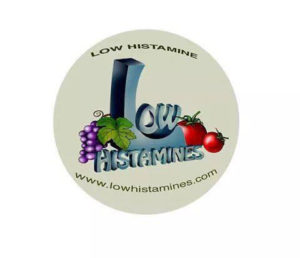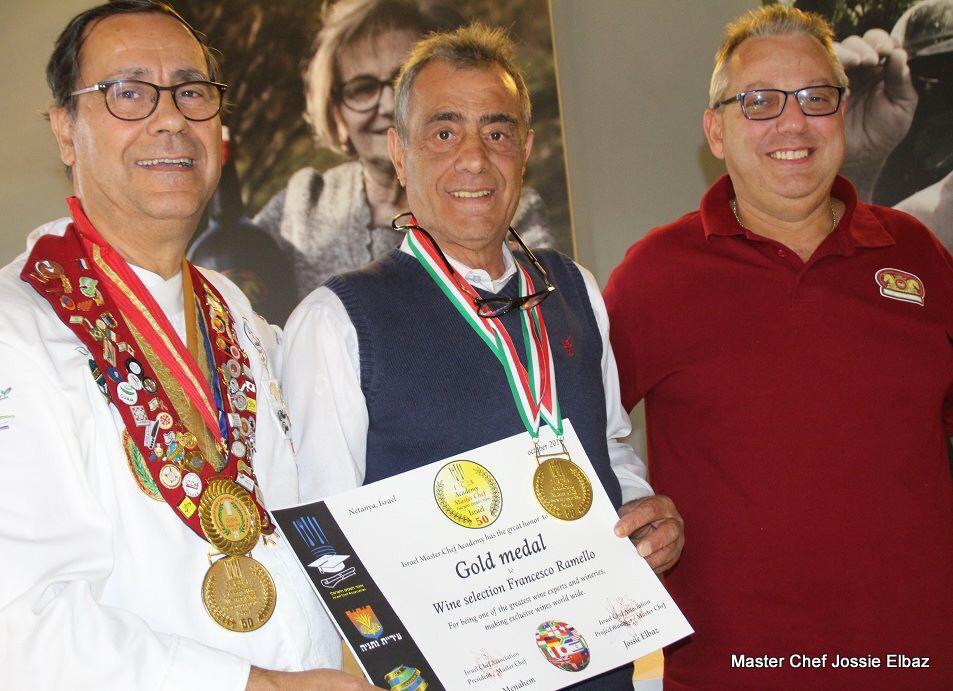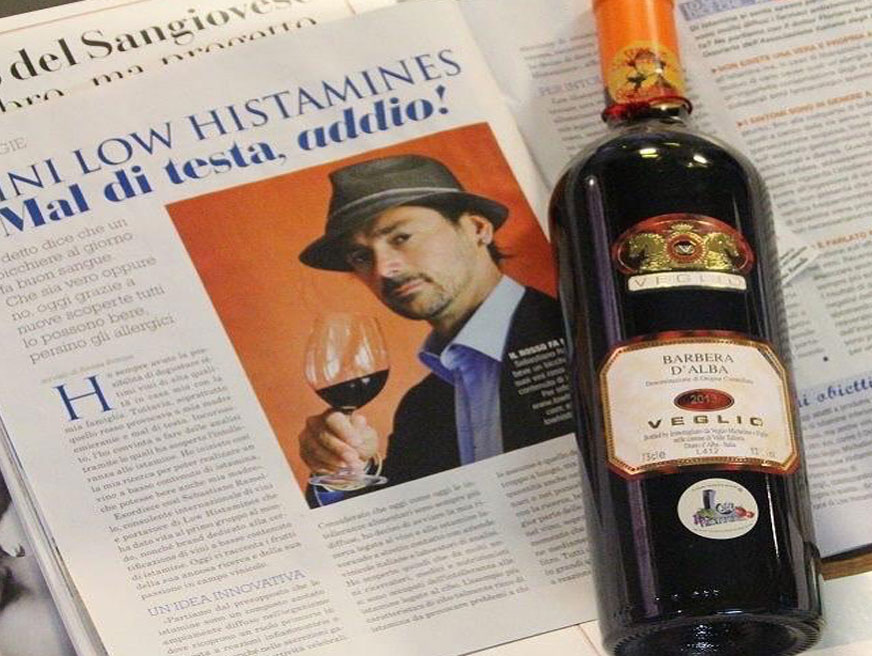We were lucky enough to meet here in India during one of his business trips, Mr. Sebastiano Ramello, International wine Consultant and wine Expert from Italy. Sebastiano is a wine ambassador, who has been travelling the world as an Italian wine selector for over 12 years, and he is also the creator of the world’s first research on wine and food intolerance, giving life to the first “Low Histamines” wines, with the content of histamines below 0.5 m/gl.

Low Histamines is a registered trademark, which certifies wines with histamine content of less than 0.5mg / liter
In this article Mr. Ramello, originally from the Piemonte region, Italy, one of the most important regions in the world for the production of high quality wines, will tell us in our interview, how his research was born.
-Mr. Ramello can you tell us and our readers how your research was born, the first of its kind in the world, on food intolerance linked to wine?
“my research, was born a little by chance, in 2012, as being an international wine consultant, I select Italian wines for the main world markets, every week I receive high quality wines from Italian wineries, to be tasted together with my staf, with the hope, of wineries, to be introduced into the portfolio wines from my customers around the world or reviewed on my media platforms. The wines that were not finished during professional tastings with my staff, ended up on the table and were drunk and finished together with friends or my family, just in this last case, every time my mother drank, even a little, wine, especially red, and we are talking about good quality wines, after less than 30 minutes he felt migraine, so that for years my father and I insisted, and pushed my mother to make medical checks at the hospital. After years, at the end of 2011, my mother made checks at the hospital, discovering that she was intolerant of histamines, the first thing that the doctor, dietician, eliminated from the diet was wine. My research was born thanks to the discovery of this intolerance of my mother. Having the opportunity to travel and attend the main wine salons, international fairs, and to deal with many experts in the sector, I was able to discover that for many years, some universities both medical, as regards food intolerances related to histamines, both schools of oenology as regards production, were studying this case and how to control histamines in wine, but at the time without having found a real solution. So that I decided to start the search for food intolerance linked to wine, first looking throughout the Italian territory for a wine that had a histamine content below the average, it means below 5 mg / liter, after having analyzed wines for about a year from various wineries, from the far north to the far south of Italy, I found a wine, a Dolcetto D’Alba Doc, produced with 100% Dolcetto autochthonous grapes, in the Langa area Piemontet, at the winery in family run Veglio Michelino & Figlio, with histamines below 5 mg/l. At this point the owner of the winery, Mr. Veglio Osvaldo, being also a well-known and qualified oenologist, has decided to become part of my research as a wine consultant for the “Low Histamines”.
The second step was to create on my part a group dedicated to research, on the one hand a medical group, in this case led by the Doctor, surgeon and well-known nutritionist Dr. Eugenio Franzero, with a medical office in the city of Turin and Milan, which has been involved in studying the effects of histamines on the human body and patients, and on the other side a group of winemakers, led by the oenologist Veglio Osvaldo, to study and understand how to control histamines in wine in a natural way. Together with Veglio Osvaldo, during years of research, I managed to control the histamines in the wine, so as to obtain wines, both red and white, with a histamine content of almost 0, below the level of 0.5mg / l.

-what factor, or what is it that produces histamines in wine?
“First, my research led me to discover, thanks to the collaboration with doctors and nutritionists, that many foods have a histamine content, for example some fresh fish such as tuna or aged cheeses, but the food (in this case food liquid) with the highest histamine content in proportion to the consumption that can be made is red wine, and this is the main cause often linked to the headache, migraine, dermatitis, colitis that some people may have after drinking wine.
you can better understand it by reading the articles and interviews made with doctor Eugenio Franzero:
http://lowhistamines.blogspot.com/2017/10/histamine-intestinal-inflammatory.html
http://lowhistamines.blogspot.com/2017/05/wine-and-food-intolerance-benefits-from.html
and also a interview made with Dr. Rebecca Perry from Australia:
http://lowhistamines.blogspot.com/2016/06/low-histamines-interview-with-dr.html
going back to your question, histamines are naturally produced by molds during fermentation, in order to obtain “Low Histamines” wines you need to obtain very healthy bunches of grapes, check that molds do not form among the berries on the plant, eliminate the berries therefore, a careful first job in the vineyard. We recommend a collection in the early morning or better at night, so that the sun and the heat cannot increase the risk of starting fermentation in the collection baskets. The grape harvest must be done quickly so that the bunches can arrive healthy in the cellar.
This is the first part of the work, about 70%, the remaining 30% of the work is done in the cellar in the first 7, 10 days of fermentation, but this part being the most complicated, for now it remains a secret of the group “Low Histamines “. Obtaining Low Histamines wines, with histamine content lower than 0.5mg / liter is not easy.
-Do the wines, Low Histamines, with this special feature, maintain the same quality as the other wines of the same kind?
“we can safely say that not only the quality is maintained, but improves, especially in the perfumes. Already in the past, over 30 years ago they studied in winemaking how to control the molds that produce histamines, at the time not yet as a risk of food intolerance, but to improve the quality of wine.
-so can we say that these wines, in addition to being healthier, and also being recommended for food intolerant to histamines, also increase in quality?
“yes, based on our research it can be said.
In the past years both we, and doctors, nutritionists, have tested our “Low Histamines” wines on people who are food intolerant to histamines (people who could not drink wine without perceiving unpleasant against indications) in different parts of the world, obtaining full success. Below you can found an interview made with a USA woman histamines food intolerant that has taste and drink the “Low Histamines” wines:
http://lowhistamines.blogspot.com/2015/07/an-interview-with-association-low.html
-Which and how many Low Histamines certified wines are in the world today?
“At the moment there are not many, as it is not easy to obtain wines with this special quality, the only “Low Histamines” certified wines at the moment are from the Langa area of Piemonte region Italy, and they are all indigenous Doc and Docg wines.
in total there are 5 different denominations, the first product, from where the whole research began, is a Dolcetto D’Alba Doc, a red wine produced 100% from Dolcetto grapes, a very fruity wine, with mainly hints of cherry, a retro almond taste, with a good dry persistence; the second was Barbera D’Alba Doc, another important red wine of my territory, produced 100% with barbera grapes, with the characteristic of having a good acidity that gives a good life to the wine; subsequently we managed to obtain a Diano D’Alba Docg (the first Low Histamines DOCG wine), a red wine produced 100% with Dolcetto grapes in the small municipality of Diano D’Alba in the heart of the Langa; until last year, for the first time, it obtained a Langhe Nebbiolo Doc “Low Histamines“, produced 100% with Nebbiolo grapes, Nebbiolo grapes are considered the most important autochthonous red grapes in Italy to obtain high quality wines, just think that with this grape important wines are produced such as Barolo Docg, Barbaresco Docg, Roero Docg and many others; in the end, at the request of foreign customers, we also managed to obtain the first white wine “Low Histamines”, a Langhe Chardonnay Doc.
– Are you planning to take your search to other wineries? even outside of Italy?
-Yes my project, together with my collaborators, is to bring the research to other wineries both in Italy and abroad. We have already been contacted by several Italian wineries, some who already follow organic and natural production, and also by foreign wineries, from South Africa, California, France and China, who knows maybe someday even wineries in india will start producing “Low Histamines” wines.
-reading the website and blog of the “Low Histamines” http://www.lowhgistamines.com
we discovered that already many magazines both Italian and from the world have spoken and mentioned your research, what can you tell us about it?
“I am very proud of this, many magazines, guides, both of wine, food but also of health have contacted me to be able to tell about my research and this innovation in the world of wine, also several Italian nationally broadcast televisions such as RAI2, Rete4, La7 have talked about this research and of the wines “Low Histamines”, years ago also the prestigious American TV, of NYC, “The Wall Street Journal” dedicated 15 minutes to our wines and to my research.
-can you already buy “Low Histamines” wines in India?
“No at the moment it is still not possible to buy “Low Histamines” wines in India, as not yet on sale and on the market, we are currently looking for the right collaborators, importers and distributors with whom to start a collaboration.
-Finally, how do you recognize “Low Histamines” certified wines on the market?
simple, they can be recognized by the certification mark found under the label at the bottom of the bottle, with the orange capsule on which there is a “Wine Selection Sebastiano Ramello” medal that guarantees quality, and in countries where a collar label explaining the “Low Histamines” research, and on the back label of the winery it is indicated that the wine contains less than 0.5mg / liter histamine.
From the beginning I decided to identify the research “Low Histamines” with the orange color, as it is a color that gives serenity and meditation.
-How long will you stop in India, and when will you come back to visit us?
“I will stay in India for a few more weeks, I will probably soon be visiting the Nashik wine territory, and then I still have some appointments in Karnataka, Bangalore and Goa, only after I can return to Italy, so that I can follow my customers who ask me, start new selections of Italian wines and follow the production of the new vintages “Low Histamines”.
-in less than two months in Italy there will be “Vinitaly” the most impressive Italian wine fair, you will be present, will you also be able to taste your wine selections and “Low Histamines” wines?
-yes as every year for over 12 years I will be present at the VINITALY wine fair, accompanying some of my customers from the main world countries, you can taste some of my selections of Doc and Docg wines and our “Low Histamines” certified wines present in the pavilion of the Piemonte region. I suggest to everyone, if present at Vinitaly, and if interested in meeting me, to hurry to make an appointment, as every year there are always many people to meet and less and less time.
We thank Sebastiano Ramello for this beautiful interview, with the hope of meeting him again soon in India or Italy in his territory of origin.
For anyone wishing more information, or contacting Mr. Ramello, he can do so through the email address: info@lowhistamines.com or piemontewine@yahoo.it
To readers: we greet you with one of Mr. Ramello’s most beautiful mottos:
“Life is too short to drink bad wines”


